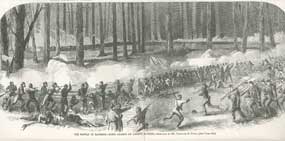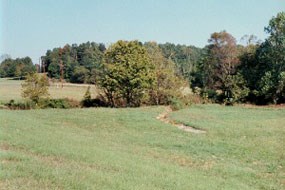
Harper's Weekly
As the battle progressed, McPherson massed 22 guns astride the road to support his infantry, while Confederate artillery also roared into action, announcing the presence of Brigadier General John Gregg's battle-hardened brigade. The ever-combative Gregg decided to strike with his 3,000-man brigade, turn the Federal right flank, and capture the entire force. Faulty intelligence led Gregg to believe that he faced only a small Union force, when in reality McPherson's 10,000-man corps was on the road before him.

Harper's Weekly 
NPS Photo
Union brigades continued to arrive on the field and deploy in line of battle on either side of the Utica road. In piecemeal fashion, McPherson's men pushed forward at 1:30 p.m., driving the Confederates back across Fourteen Mile Creek. The ensuing fight was of the most confused nature, for neither commander knew where their units were or what they were doing. However, Union strength of numbers prevailed. The Confederate right flank along the Utica road broke under renewed pressure, and Gregg had no alternative but to retire from the field. His regiments retreated through Raymond along the Jackson Road, bivouacking for the night near Snake Creek. There was no Federal pursuit as McPherson's troops bedded down for the night in and around the town. The fight at Raymond cost Gregg 73 killed, 252 wounded, and 190 missing, most of whom were from the 3rd Tennessee and the 7th Texas. McPherson's losses totaled 446 of whom 68 were killed, 341 wounded, and 37 missing. Now secure in his position, Grant could begin to pressure Jackson, the capitol of Mississippi. 
Harper's Weekly |
Last updated: February 15, 2018
